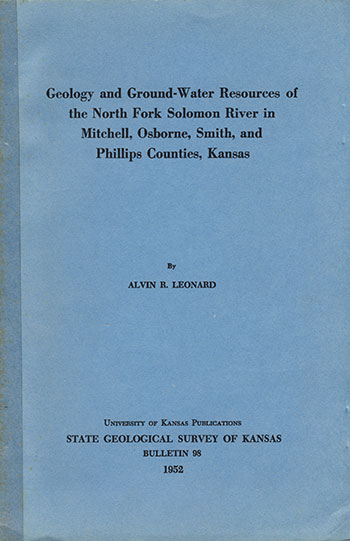Geology and Ground-water Resources of the North Fork Solomon River in Mitchell, Osborne, Smith, and Phillips Counties, Kansas
By Alvin R. Leonard
(U. S. Geological Survey)
with a chapter on the chemical quality of the ground water by Walton H. Durum (U. S. Geological Survey)

Originally published in 1952 as Kansas Geological Survey Bulletin 98. This is, in general, the original text as published. The information has not been updated. An Acrobat PDF version (39 MB) is also available; plates available separately.
Abstract
This report describes the geography, geology, and ground-water resources of the valley of the North Fork of Solomon River in north-central Kansas from the west side of Phillips County to the confluence of the north and south forks in northwestern Mitchell County. The area is from 2 to 3 miles wide, is 84 miles long, and extends across Phillips, Smith, Osborne, and Mitchell Counties. The area has a subhumid climate, average normal precipitation being about 22.5 inches and the mean annual temperature about 54° F. Farming and livestock raising are the principal occupations; wheat and corn are the major crops. A few farms are irrigated with surface water in dry years. Oil and construction materials are produced in the area.
The exposed rocks range in age from Cretaceous to Recent. A map showing the surface geology and cross sections illustrating the relation of the various formations are included in this report. The Pleistocene alluvial deposits, which range in age from Kansas to Recent, are the important aquifers in the area. The shape and slope of the water table are illustrated by a map that shows contours of the water table and depth to the water table in wells. This map shows that ground water moves downstream and toward the river.
Ground-water recharge in the area is largely from local precipitation; groundwater discharge is mainly by seepage into streams and transpiration by plants. All municipal and industrial water supplies and most of the domestic and stock supplies are obtained from wells. In the eastern part of the area some surface water has been used for irrigation.
The principal mineral constituents of the ground water are discussed with relation to its occurrence and use. The water is hard and mineralized and samples from different formations are similar in their content of dissolved solids. Nitrate in excess of 45 parts per million, identified with surface seepage, is found in both the terrace deposits and the Crete member of the Sanborn formation. Base flow in the North Fork Solomon River is nearly free from nitrate and shows a slightly lower mineralization than is found in the ground water. A rating based on the present chemical quality of the ground water is included for use in planning for irrigation in this area. All ground water in the area rated "good to permissible" or better for irrigation purposes.
The hydrologic and geologic field data upon which this report is based include records of 244 wells, chemical analyses of water from 22 wells and 8 municipal supplies, and logs of 122 wells and test holes including 57 test holes drilled as a part of this investigation and 19 drilled along the site of the proposed Kirwin dam by the Bureau of Reclamation and Corps of Engineers.
Kansas Geological Survey, Geology
Placed on web May 24, 2014; originally published November 1952.
Comments to webadmin@kgs.ku.edu
The URL for this page is http://www.kgs.ku.edu/Publications/Bulletins/98/index.html